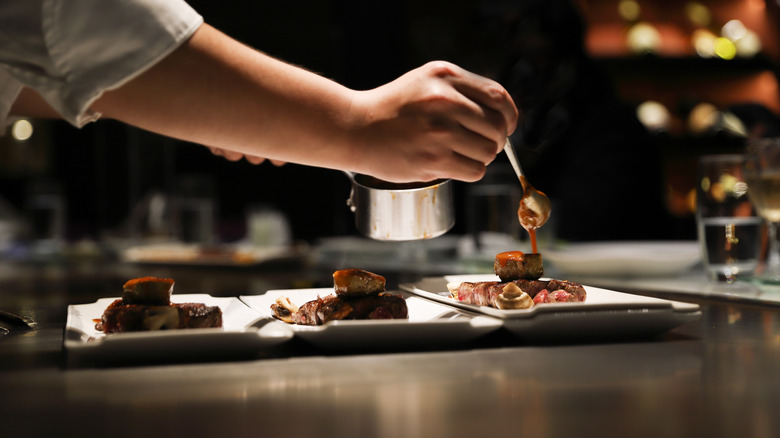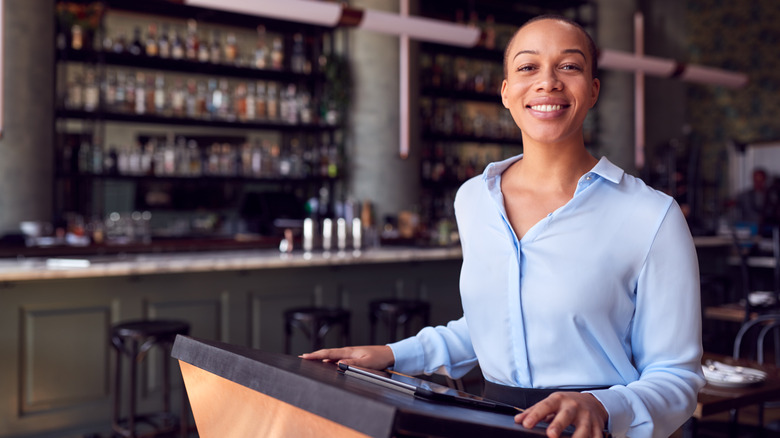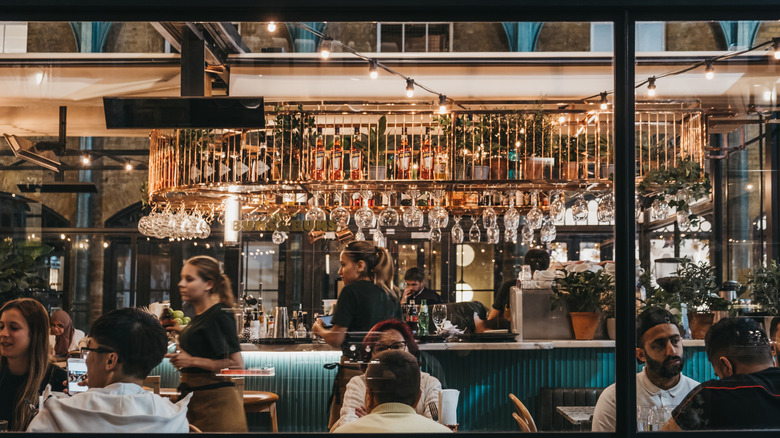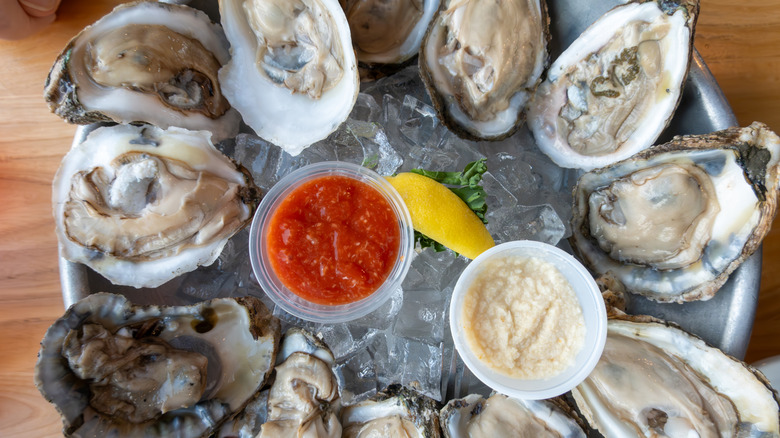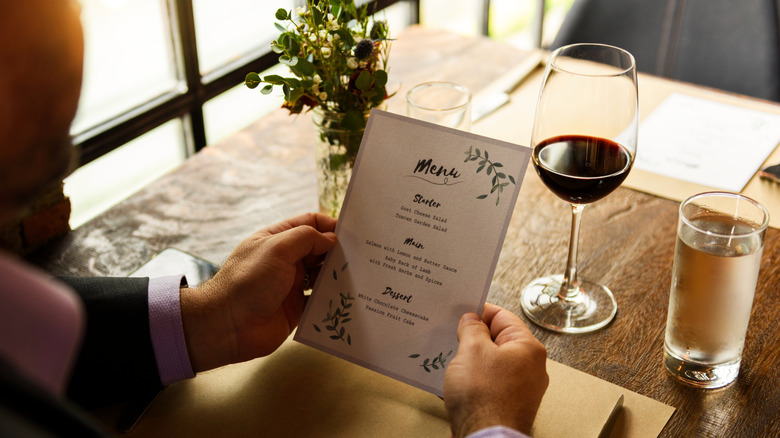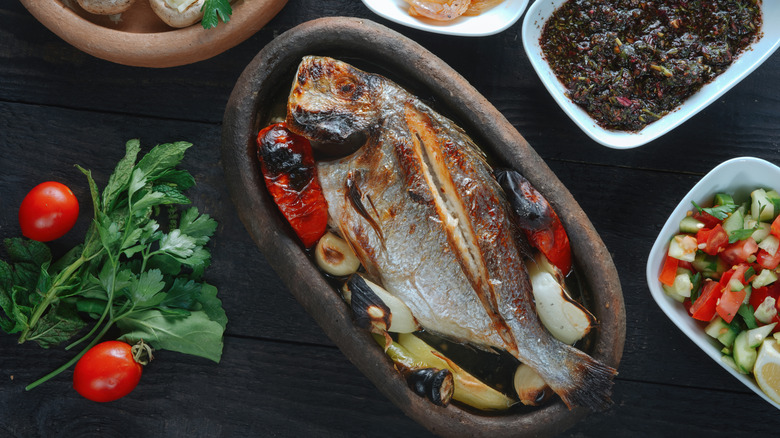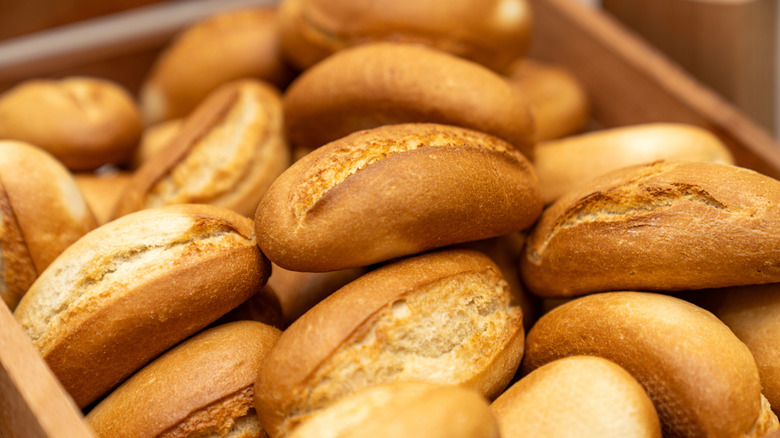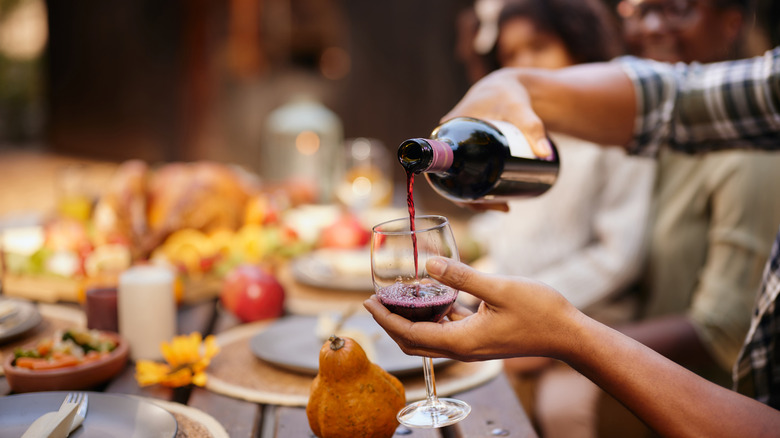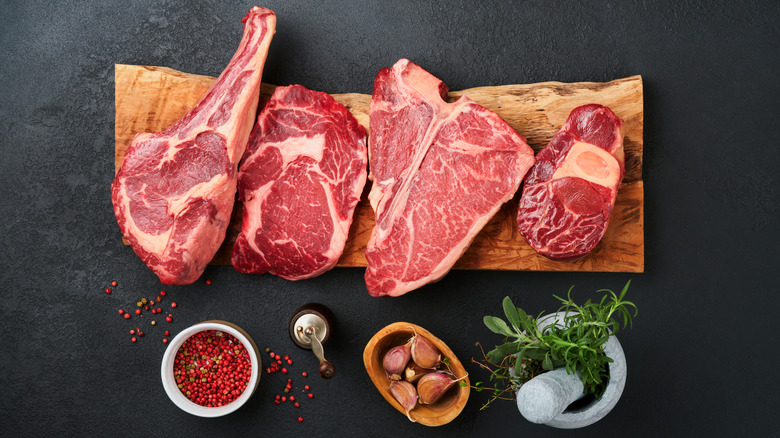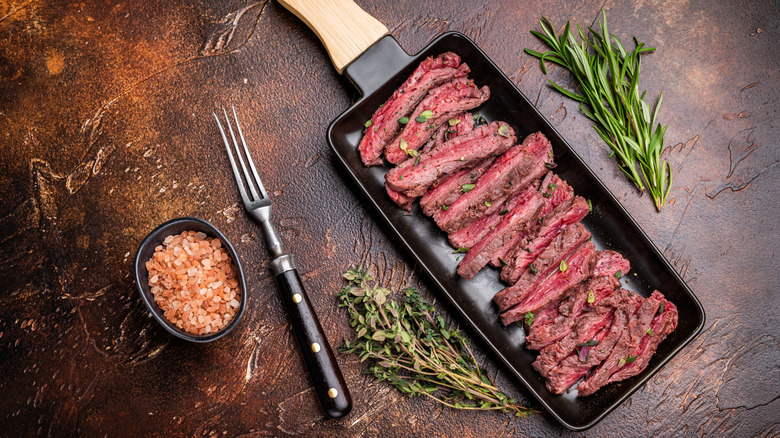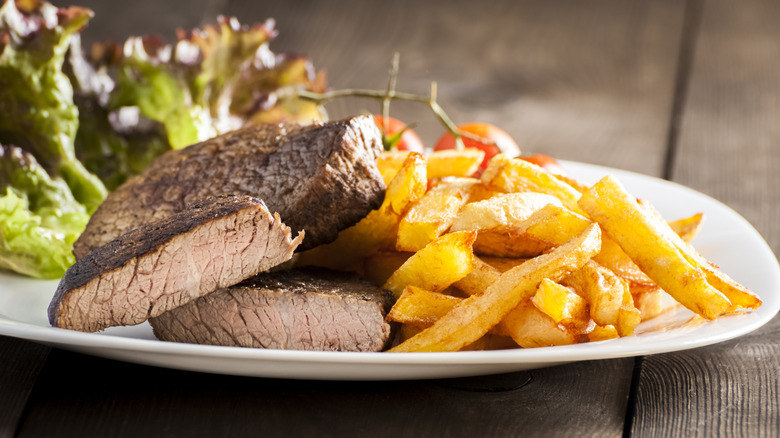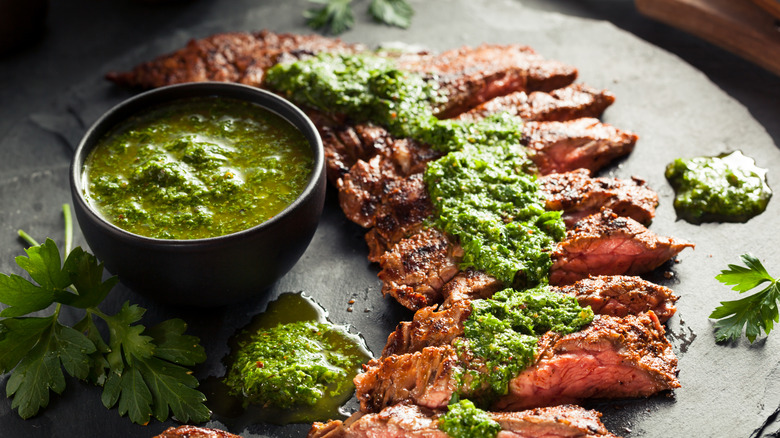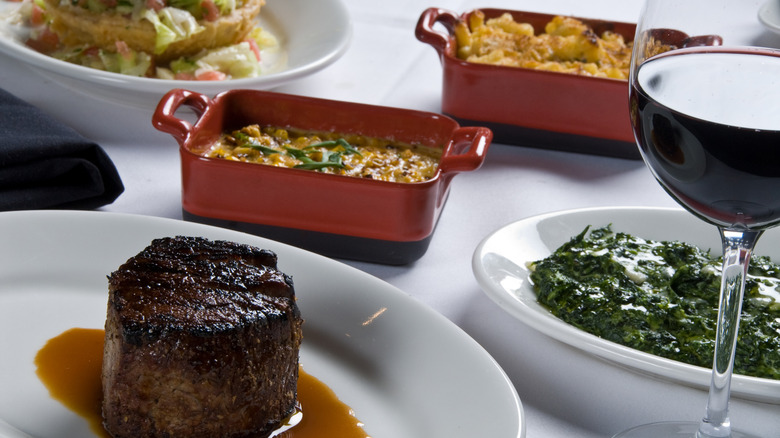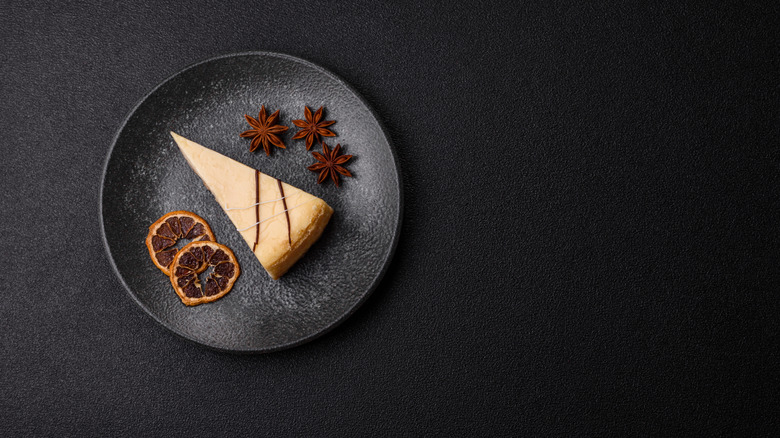16 Mistakes That Can Ruin Your Steakhouse Experience
Filet mignon. Beef tenderloin. Creamed spinach. Shrimp cocktails. New York cheesecake. Over time, these items have become synonymous with steakhouse dining. Such rich dishes are symbols of the indulgent experience these eateries provide, and are sought-after by those looking to enjoy the finer points of this cuisine. However, it's not just high-quality steaks and prime cuts that steakhouses are known for. They're also recognized for their ambiance: dark wood, leather, white tablecloths, and dimmed lighting conjure moody and romantic atmospheres. Consider too the knowledgeable staff and commitment to service which almost always accompany a meal at one of these establishments, and it's no wonder that a steakhouse dinner is a coveted one.
With all these elements in place, it might seem a no-brainer that every steakhouse reservation will provide a memorable meal — but that's not always the case. If you go in unaware, there are several mistakes that can tarnish this special experience.
Discover the biggest oversights that can ruin your steakhouse experience — and how to avoid them.
Not making a reservation
There's nothing worse than having to wait when you're hungry — but that's what could happen if you don't plan ahead and make a reservation at your favorite steakhouse. While most restaurants don't require reservations and will accommodate walk-ins, that doesn't mean it's hassle-free. At peak dining hours, popular restaurants can have long wait times which stretch to an hour or more.
Well-known steakhouse chains such as Ruth's Chris tell guests that they may not be able to accommodate walk-ins due to the high number of reservations, so a guaranteed time slot is strongly recommended. Other chains, like LongHorn Steakhouse, do not take reservations, but feature a call-ahead system which allows patrons to place their name on the list before arrival and reduce their wait. Be sure to confirm policies at your favorite restaurant by phone or website ahead of visiting to keep your wait to a minimum.
Only dining during peak hours
Enjoying a busy restaurant at 7 or 8 p.m. on a weekend can feel luxurious, and might be a favorite way to spend your leisure time. Though enjoyable, these peak dinner times can also majorly hinder your overall dining experience.
During the dinner rush, restaurant staff are stretched thin. Both front-of-house and back-of-house staff juggle multiple tables and aren't able to commit as much time to any given order. When dining off-peak, it's not only easier to score a reservation at your favorite spot, but you can also usually expect a higher level of service. Some restaurants even incentivize diners to visit during off-peak hours by increasing loyalty perks or offering early-bird menu specials.
Not only can dining earlier than usual enhance your experience, but it can be good for your health too. Eating late might increase the risk of obesity, shows ties to increased body fat, and potentially hinders weight loss. Opt for a 5 or 6 p.m. dinner instead to help regulate your appetite and hormone levels before bed and enjoy a higher-quality experience overall. It's a win-win!
Not asking your server questions
Servers are the experts when it comes to restaurant menus. More than often they have tried all the items, making it easy for them to provide added details about a dish or share suggestions. They can offer the down-low on everything from portion sizes to preparation methods — and even give feedback on customer queries like appetizer-entrée pairings.
Experts, however, recommend being specific when asking for advice. A general question such as, "What would you recommend?" isn't always helpful, since each table will have different preferences. Instead, consider sharing a few drinks or dishes you typically like with the server, so they can get a sense of your personal taste. This will make it much easier for them to guide you to a meal you'll enjoy. You can also ask what the most popular dishes are to get a sense of what other patrons are digging into.
Walking in unaware of the prices
Between wine, entrees, sides, and dessert, steakhouses are inherently expensive. Numbers can quickly add up and result in sticker shock if you pop into a steakhouse oblivious to the high price tag. While charges for steaks at affordable chains can be more palatable, steakhouses use high-grade meats and expensive imported ingredients that cost more for the restaurant to purchase. Steakhouses also require specialized equipment that not all restaurants use. All of these factors can drive up the menu prices to cover costs (though some more expensive steakhouses may not be worth the price).
When sitting down at a steak dinner, patrons can expect to spend anywhere from $40 to $150 per person (or significantly higher depending on the quantity of appetizers, drinks, and other add-ons). If prices are a deterrent, consider instead saving steakhouse dinners for special occasions — or visit for lunch instead when the prices are a little more reasonable.
Skipping the signature appetizers
Steak may be the star of the show, but don't skip out on the delicious appetizer course in favor of saving room. A few standout steakhouse appetizers include wedge salads, raw bar items like oysters and shrimp cocktail, crab cakes, or French onion soup.
These apps tend to fall into two camps: briny (like oysters), or rich and decadent. The two contrasting flavor profiles complement steak well. The fresh, saltiness of seafood contrasts with the umami of the main course, as does the creamy sweetness of offerings such as French onion soup.
Appetizers are vital at a steakhouse because they offer variety which is often unavailable when selecting only from the entrees, Logically, the majority of the mains at a steakhouse are steak cuts. The appetizers, however, have much more to choose from with seafood, vegetables, and other ingredients you may not find later in the meal. Just like the bread course, be cautious not to overdo it so you can save room for what follows.
Ordering the daily specials
The daily specials at a restaurant can be tempting, and you might see them as a limited-time meal you don't want to pass up. Celebrity chefs like Gordon Ramsay, however, recommend avoiding these rotating daily entrees. Instead of being an opportunity for the chef to express their creativity, daily specials are often a way for the kitchen to use up leftover ingredients from days prior before they go bad. While this isn't always the case, it can be hard to determine if it's true by simply looking at the menu.
Another downside of specials is that they sometimes don't align with the rest of the menu. For example, if a steakhouse offers a pasta dish as a special, it may not fit the rest of the menu's vibe — which can lead to a disjointed dining experience. Though ordering the daily specials isn't a guaranteed mistake, it's best to look at them critically to determine if it's worth your while.
Choosing a seafood entree
You wouldn't go to McDonald's an order a salad, right? No — you'd likely opt for one of their signature dishes: a burger. The same logic applies when visiting a steakhouse.
While some steakhouses offer delicious seafood, it's not exactly their specialty (with the exception of steak-centered dishes like surf and turf). Some experts recommend avoiding seafood dishes not just at steakhouses, but all non-seafood restaurants. This is because they may not be able to source or prepare the seafood to the same standard.
Though a high-quality steakhouse shouldn't have issues with quality or freshness, it may be best to err on the side of caution and opt for one of their premier cuts of beef to avoid disappointment. If your heart is set on a seafood meal however, look for indicators on the menu such as "day boat" specials or an extensive raw bar selection. These usually mean the steakhouse will turn out a decent aquatic dish.
Overindulging on bread
Many steakhouse chains like LongHorn, Fleming's, and Outback all offer mouth-watering bread courses. Some are even revered for this complementary dough, such as Texas Roadhouse's fan-favorite pillowy rolls and famous cinnamon butter (though some may argue that Outback has the better bread). However, one mistake many diners make is tucking into this carb-loaded course a little too enthusiastically.
While there are various theories as to why the ever-popular bread basket is served — from keeping diners' hunger and impatience at bay to showcasing the kitchen staff's baking skills — one thing is true: Eating too much bread will monopolize precious space in your stomach before your entrée arrives. It's best to practice self-restraint and enjoy only a piece or two before your food arrives, instead saving the bread to munch alongside your entrée as opposed to before it. This allows you to enjoy both equally, without accidentally overdoing it.
Choosing the wrong bottle of wine
Picking the right wine to accompany any meal is a skill — and one that could make or break your dining experience. When you pair the wrong food and wine together, it might make the throw off the alcohol's taste. Sweet food can make wine taste bitter and acidic, while salty food can make wine taste too fruity.
While red wine is the classic choice when eating steak, white wines like Chardonnay can also pair well with red meat. Rich wine tends to pair well with the richness of steak and steakhouse sides like creamed spinach and mashed potatoes, but wine lists will sometimes overwhelm. When all else fails, just ask.
Servers are well-versed in providing recommendations, and many restaurants will pour a sample to taste before committing to a glass or entire bottle. Many high-end restaurants also keep a sommelier on staff who can make an expert wine pairing which will undoubtedly elevate your dining experience.
Not understanding the different cuts
Those unfamiliar with different steak cuts may think, "steak is steak." However, this couldn't be further from the truth. The various cuts of meat come from multiple sections of the cow, which means they have varying levels of fat and muscle. It also means the levels of tenderness can differ dramatically.
Understanding the difference between steak types will help ensure you choose a cut you'll enjoy when ordering at a steakhouse. Beef tenderloin, for example, comes from the area below the cow's backbone(known as the loin), which is one of the least-used muscles in the cow. This means it's ultra-tender and marbled, making it one of the most sought-after steaks. On the other hand, hanger and skirt steak are more affordable cuts sourced from the flank, or the muscular area below the loin. Though they can be chewy when cooked and sliced improperly, they feature a delicious flavor that is especially enjoyable with a side of fries. If you're looking for something tender and juicy like a tenderloin — and order a flank steak instead — you may be disappointed, so it's important to understand what's on offer.
Skipping cheaper cuts of beef
As mentioned, cuts like skirt steak or hanger steak have a reputation for being more affordable. While this is perfect for home chefs looking to save on their grocery bills, it also means these steaks may not be at the top of most wish lists when visiting a steakhouse. They often get overlooked in favor of flashier cuts like filet mignon or ribeye.
These cheaper cuts can be delicious and tender when cooked properly. Hanger steak, for example, has enough fat content to be tender and juicy when cooked well and sliced against the grain. Short rib is another selection that is fall-off-the-bone tender when braised over a low heat for hours. It's rich and beefy, offering a similar flavor to ribeye for a fraction of the price. So while you likely won't be disappointed if you opt for a premium cut at the steakhouse, don't discount these more affordable alternatives that can still be full of flavor.
Opting for a well-done steak
There's one big question when ordering steak: How do you like it done? Diners can choose any level of doneness based on personal preference, from mostly pink to thoroughly cooked. The internal temperature target for rare steaks should be 120 degrees Fahrenheit, while well-done steaks must be heated to 160 degrees Fahrenheit or higher. Though each level has pros and cons (which can vary depending on the cut), there's one preparation style that experts seem to agree to avoid: well-done.
As steak cooks, the protein structure changes and affects its flavor and texture. The longer it is cooked, the more moisture it loses and the more fat is rendered out. This causes the steak's natural juices to seep out, leading to a lack of flavor and a tough texture. While this is especially applicable to well-done steaks, some experts recommend avoiding any steaks cooked past medium — making medium-well off the table, too.
Skipping the sauces
When cooked properly, steak may be delicious on its own — but it's even better when paired with a few delectable sauces. Steakhouses typically keep a variety of standards on offer, allowing you to try a handful and find your favorites.
Herb-infused compound butter is a crowd-favorite addition to your steak. Some restaurants even serve it atop their beef cuts by default. While the exact herbs vary, you're likely to find a mix of chives, oregano, parsley, thyme, and rosemary. Peppercorn sauce is a French staple, made with cream, shallots, and paper to complement steak's richness. Bernaise, another French sauce, is an ultra-rich pairing.
If you're looking for something fresher, chimichurri is a more herbaceous, acidic alternative; made with a blend of cilantro, parsley, and vinegar. Salsa verde will also satisfy the craving for a brighter dressing. No matter your preference, consider ordering a few sauces on the side so you can enjoy your steak multiple ways in a single meal.
Ordering too few sides
At many steakhouses, steaks are the star of the show — and for good reason. They're high-quality, flavorful, and tender. But don't let the steaks overshadow another delicious component of any steakhouse meal: the sides. These must-have dishes elevate the experience from a simple dinner to an elegant dining experience.
Once you select your steak you'll likely have to order your sides a la carte, allowing you to pick and choose the ones you like best. Rich classics such as creamed spinach, mac and cheese, and mashed potatoes add decadence to your meal, playing into the richness of the steak. Vegetable-focused sides, like Brussels sprouts, salads, grilled asparagus, or grilled tomatoes cut through the richness and provide a bright, fresh bite. Mixing and matching different offerings while considering which sides go with your chosen steak cut help to round out your meal and ensure you taste everything the steakhouse has to offer.
Rushing through your courses
Most people don't just visit a steakhouse for the food — they also dine for the overall experience. The ambiance, the service, and the commitment to quality all work together to create a memorable atmosphere that is typically a cut above the rest. So why rush it?
Though some diners prefer to eat at a quick pace, expect to spend an hour or two depending on party size to properly enjoy your meal. This window can be longer depending on a variety of factors: how many courses you order, preparation time at the kitchen or bar, and whether you cap your dinner with dessert or an extra glass of wine. Steakhouses are all about service, so they likely won't hurry you along unless your time at the table gets excessive. Go slow to ensure you can savor a nice, leisurely meal and make your experience worth it.
Filling up before dessert
Between delicious appetizers, mouth-watering steak, warm bread rolls, and decadent sides, it can be tempting to eat your fill before the dessert menu arrives to the table. At most steakhouses, this would be a big mistake. After such a savory dining experience, a sweet and rich dessert is the perfect final component to your meal.
Though steakhouses offer a variety of desserts, there are a few iconic menu items that they're best known for: luscious chocolate lava cake, creamy New York cheesecake, and caramelized crème brûlée. Each of these indulgent desserts shares one commonality: they're ultra-rich and perfectly sweet to both complement and contrast the beefy, umami flavor of steak entrees. Though many steakhouse chains also offer other desserts besides these three traditional dishes, you can never go wrong with these classics to conclude your meal — especially if you have a sweet tooth.
